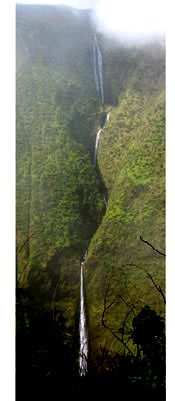Part 1: Hydro Systems Overview
Bookmark this page (Ctrl+D)
![]() View/Print PDF Version
View/Print PDF Version
Guide Navigation
How Water Power Works

Water power is the combination of HEAD and FLOW.
Consider a typical hydro system. Water is diverted from a stream into a pipeline, where it is carried downhill and through the turbine (FLOW). The vertical drop (HEAD) creates pressure at the bottom end of the pipeline. The pressurized water emerging from the end of the pipe creates the force that that drives the turbine. More FLOW, or more HEAD, produces more power.
HEAD and FLOW are the two most important things you need to know about your site. You must have these measurements before you can seriously discuss your project, the power it will generate, or the cost of components. As you will see, every aspect of a hydro system revolves around Head and Flow. Remember:
-
HEAD is water pressure,
which is created by the difference in elevation between the
water intake and the turbine. HEAD can be expressed as
vertical distance (feet or meters), or as pressure, such as
pounds per square inch (psi).
- Net Head is the pressure available at the turbine when water is flowing, which will always be less than the pressure when the water is turned off. As we’ll discuss later, pipeline diameter has a major effect on Net Head.
-
FLOW is water quantity,
and is expressed as “volume per second or minute” such as
gallons per minute (gpm), cubic feet per second (cfs) or
liters per second (lps). Both HEAD and FLOW must be
present to produce water power.
- Design Flow is the maximum FLOW for which your hydro system is designed. It will be less than the maximum Flow of your stream (especially during rainy season), and is often a balance between power output and cost.
Net HEAD and Design FLOW are used to specify hydro system components.
The importance of accurate Head and Flow measurements cannot be overemphasized. Later in this Guide, we’ll discuss How to Measure Head and Flow.
Power Conversion & Efficiency
In reality, the generation of electricity is simply the conversion of one form of power to another. The turbine converts water power into rotational power at its shaft, which is then converted to electrical power by the generator. It is important to note:
- Power is never created; it can only be converted from one form to another.
- Some of the power will be lost through friction at every point of conversion. Efficiency is the measure of how much energy is actually converted.
The simple formula for this is:
Net Power = Gross Power x Efficiency
While some power losses are inevitable as water power gets converted to electricity, they can be minimized with good design. Each aspect of your hydro system, from water intake to turbine-generator alignment, affects efficiency. Turbine design is especially important; a good turbine supplier will work closely with you to specify a turbine with dynamic operating characteristics that match your Head and Flow.